The Best National Parks in Norway: Tips, Map, Things to Do

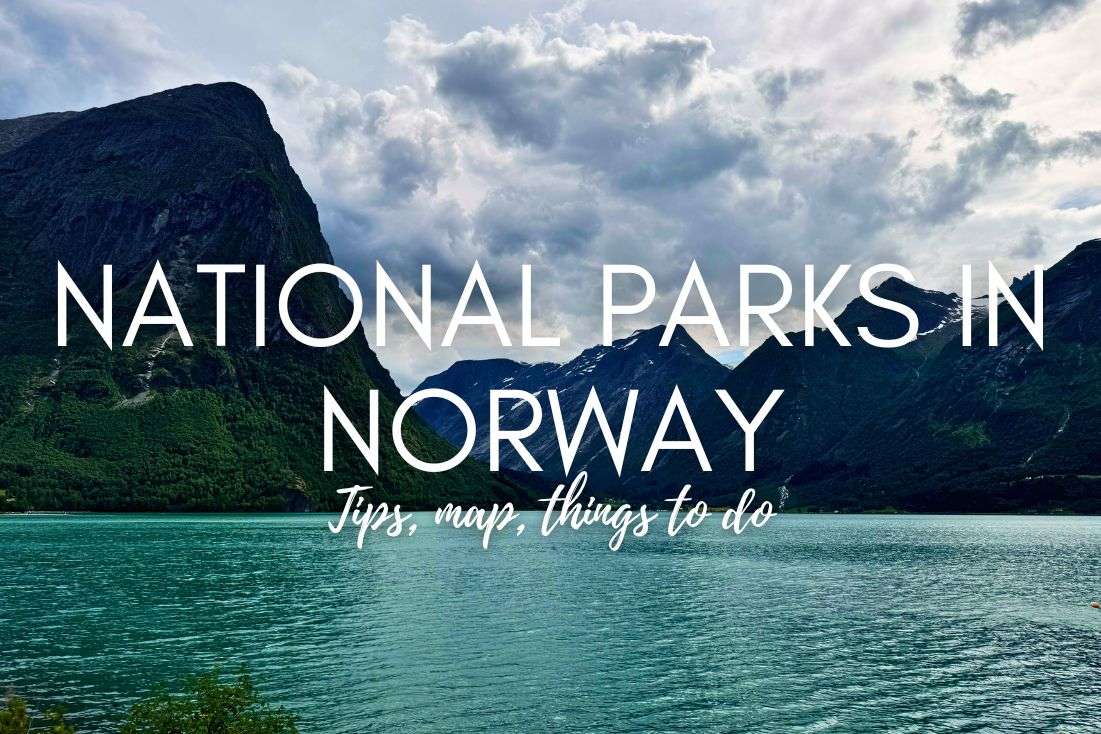
From north to south, Norway’s varied landscape brings all the drama, and its national parks deliver the country’s natural beauty in full force. If you’re a fan of epic mountain views, glacial lakes, and tranquil forests, the national parks in Norway are calling your name—just as they did mine!
Just know that you won’t be roaming around from the comfort of a vehicle; almost all of Norway’s national parks are actually car-free zones, with strict regulations that keep the wilderness, well, wild. Roads, hotels, and visitor centers are often just outside park boundaries, which keeps all the countryside clean and tidy (and also means you’ll be doing plenty of walking).
And speaking of walking, Norway is a hiker’s very own European mecca. And since hiking is my thing, in this article, you’ll find more tips on hiking trails than anything else. Oh, and for the record, it’s also possible to do many of the other activities that I mention (skiing, mountain biking, kayaking etc.) in more than one national park.
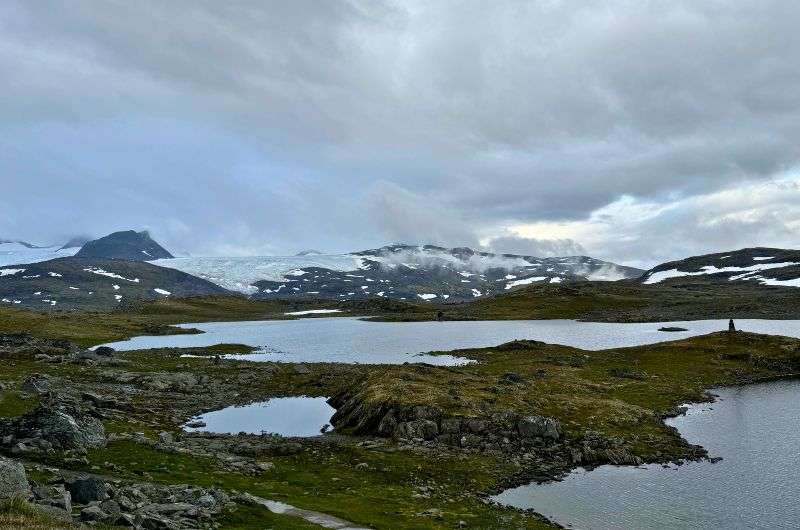
The jaw-dropping nature of Norway
So, if you’re planning to visit the national parks of Norway, read on for THE best tips, things to do, and top answers to FAQs—all from my own experience, as ever! Learn more about Norway.
An overview of the best national parks in Norway:
- Folgefonna National Park (Vestland)
- Jostedalsbreen National Park (Vestland)
- Lofotodden National Park (Nordland)
- Jotunheimen National Park (Innlandet and Vestland)
- Hardangervidda National Park (Buskerud, Vestland, and Telemark)
- Rondane National Park (Innlandet)
- Breheimen National Park (Innlandet and Vestland)
- Møysalen National Park (Nordland)
Sometimes, all you need to do is take the first step... I've filtered out the best hotels in Norway for you
Save it for yourself to come back to later, or share with your friends on social media!
See my 14-day Norway itinerary for easy ways to slot some of these best national parks into your own trip:
Visiting Norway’s national parks: Quick tips
The best time of year to visit Norway...
...is between June and September. During these months, the weather is milder, most snow has melted from the national parks’ trails, and the midnight sun keeps the days long, especially in the north. But for winter activities like skiing or northern lights viewing, December to March is ideal, but be prepared for very short days and colder weather.
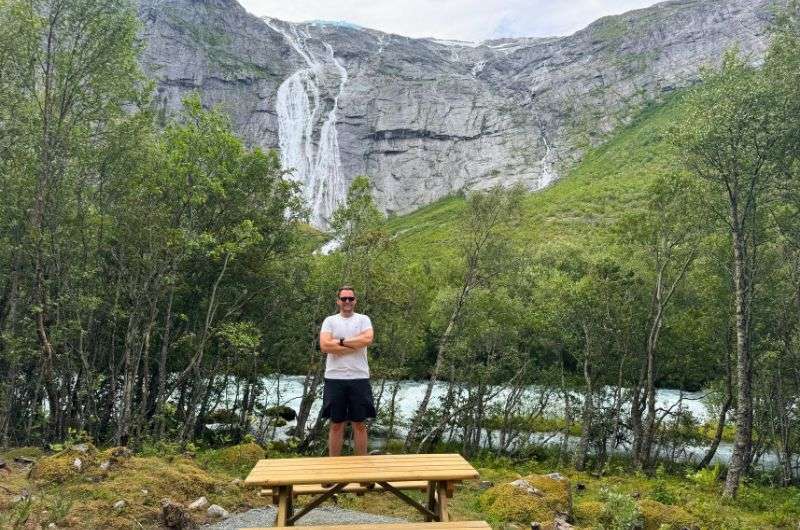
On my way to Briksdal Glacier
You might also be interested in reading my article on the best time to visit Norway, depending on what you want to get out of your trip:

The weather in Norway...
...changes its mind more often than a woman re-decorating her living room. As a rule, expect the unexpected, and that means rain, wind, or snow, even in summer.
But to generalize, along the coast and in the fjord areas, the climate is milder and wetter. The interior and northern areas tend to be chillier but drier. In the summer, expect average temperatures between 10 and 20°C (50–68°F), though it can get cooler in the mountains. Winters are cold, with temperatures dipping well below 0°C (32°F) in many regions.
Tip: Check the weather forecast daily on your Norwegian vacation.
What to pack for the national parks in Norway
Packing smart for Norway’s national parks means layers, layers, and more layers. Here’s the checklist that I use on my trips to Norway:
- Clothing: Pack moisture-wicking base layers, a warm fleece or down jacket, a waterproof and windproof jacket, and durable hiking pants. In winter, bring thermal layers and a thicker coat.
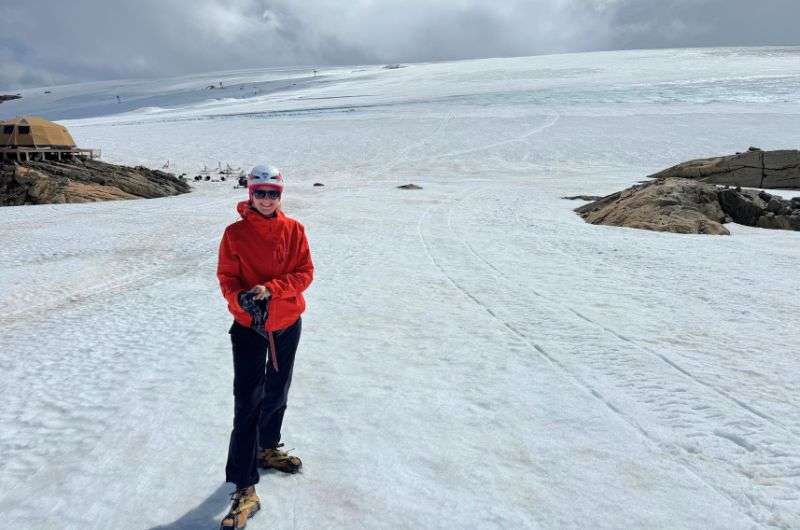
Don't forget extra layers for winter weather! Norwegian winter is no joke
- Footwear: Sturdy, waterproof hiking boots are essential all year round. In winter, consider micro spikes or crampons for icy trails.
- Essentials: A good quality backpack, reusable water bottle, and trekking poles are helpful on steep trails.
- Accessories: A hat, gloves, and sunglasses (the sun can be intense, especially with snow glare). Don’t forget a buff or scarf for extra warmth.
- Extras: A map, a compass, a first aid kit, a portable charger, and a headlamp if you’re going to be out for longer hikes or during shorter daylight hours.
The best national parks in Norway: map
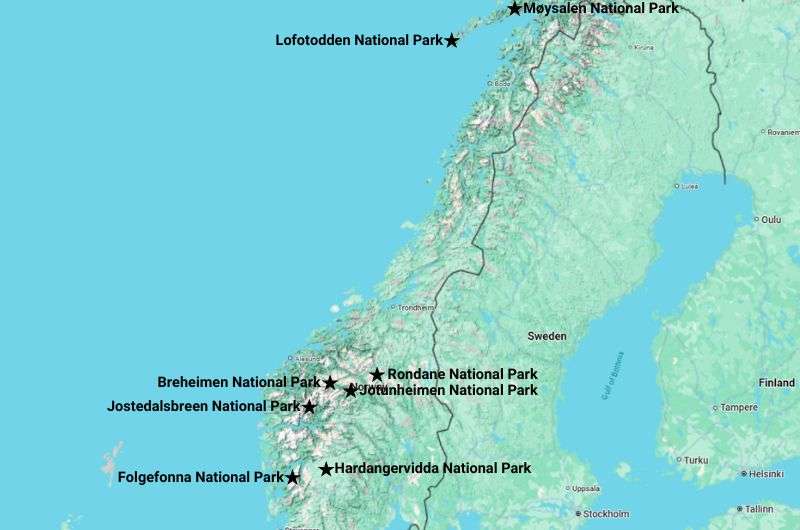
A map pinpointing the best national parks in Norway
1. The best things to do in Folgefonna National Park
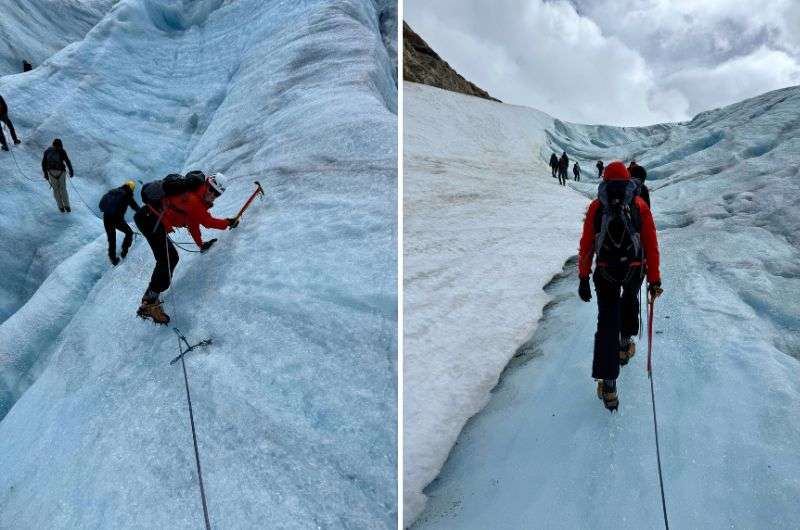
Hiking the Folgefonna glacier
What’s good to know
- Location: Vestland, southwest Norway
- My hotel recommendation: Trolltunga Hotel, Odda
- What to expect: Lots of glaciers, and then even more glaciers
Go glacier hiking
People come to Folgefonna National Park for one thing and one thing only: the glaciers. Sure, this national park is a bit of a one-trick pony, but boy, what a trick it is: blue ice, vast white cliffs, and some of the most unique landscapes I’ve ever laid eyes on.
Fun fact: Folgefonna is the southernmost glacier in Norway, and the third largest glacier on the mainland.
I’ve listed the guided blue ice tour of Folgefonna glacier itself as one of the best hikes in Norway, but there are several other great hikes to challenge yourself to, such as...
- Buer to Buarbreen glacier (Google Maps link to trailhead): A difficult trail featuring mountain streams and chain ropes, but it’s worth it for a chance to see the glacier calving.
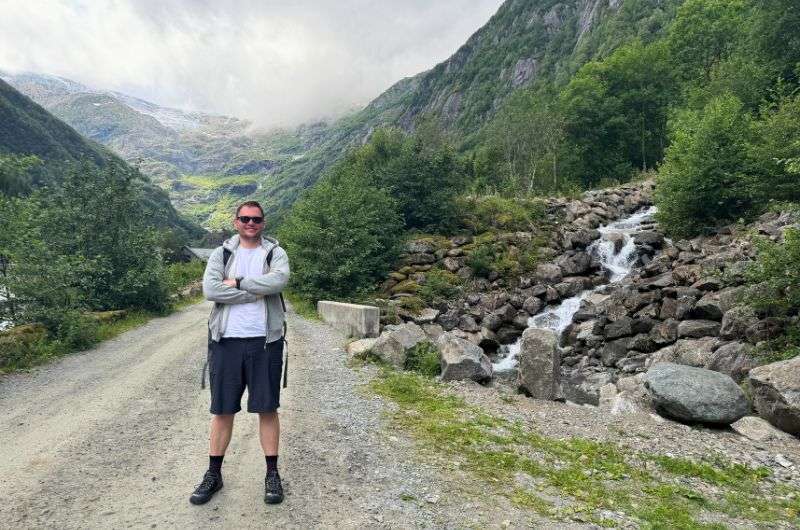
You can see a little bit of the Buarbreen glacier behind me
- Bondhus to Bondhusvatnet (Google Maps link to trailhead): A more leisurely hike with the promise of a positively stunning lake at the end of it
- Blådalsvatnet to Svelgabreen glacier (Google Maps link to trailhead): Long and muddy, but this is where you get the most spectacular views over Folgefonna.
Important note: If you actually want to get onto the glaciers, you’ll need specific equipment and to go with a guide, or at least, have a lot of experience with ice trekking by yourself.
Go glacier kayaking
To get up close and personal with a glacier from a different approach, you can take a unique kayak tour on Møvatnet lake. Let me tell you, it’s quite a breathtaking experience to bob up and down in a tiny boat in among some hella mighty icebergs.
You haven’t got to get too close to the glacier itself because of the chunks of ice that fall from it. This is why you need to kayak with a guide—they’ll provide you with all the equipment, including a dry suit, as well as keep you at a safe distance on the water.
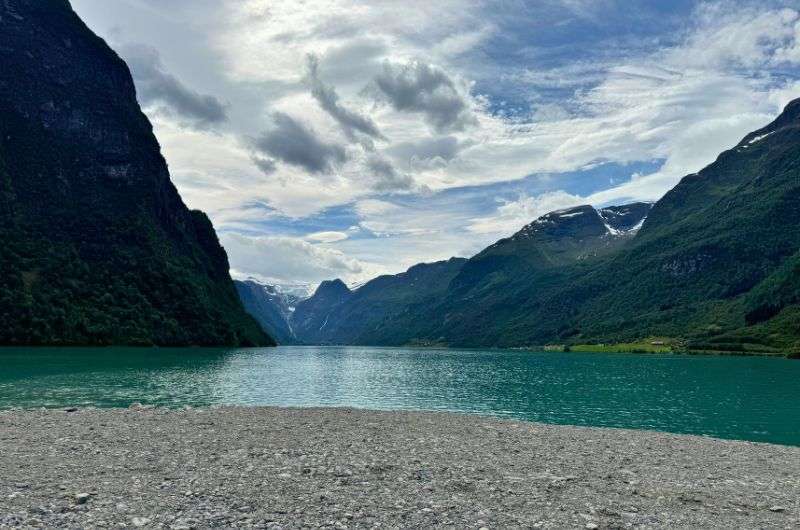
Møvatnet lake
- When? The kayak tour runs between July and mid-September.
- Where? The start and end point is in Rosendal.
- How? You need to book ahead at folgefonni.no. Prices for the tour start at NOK 2,890 (USD 260).
- How long? Expect to kayak for about 6 hours, around 3 km in total (1.9 mi).
- Anything else? Kids need to be at least 15 years old to take the tour. Bring sunglasses, sunscreen, and a towel. Wear woolen clothes, even underwear, because it’s frickin’ freezing (shocker).
Go summer skiing
If you’ve ever wanted to ski in July with a view over the Norwegian fjords, FONNA Glacier Ski Resort’s got you covered. Set right on the Folgefonna glacier, this place lets you carve down wide slopes with sweeping views of fjords, mountains, and even the North Sea on a good day.
Skiing on fresh snow under a summer sky is just another surreal experience that this national park has to offer. Cross this off your summer bucket list!
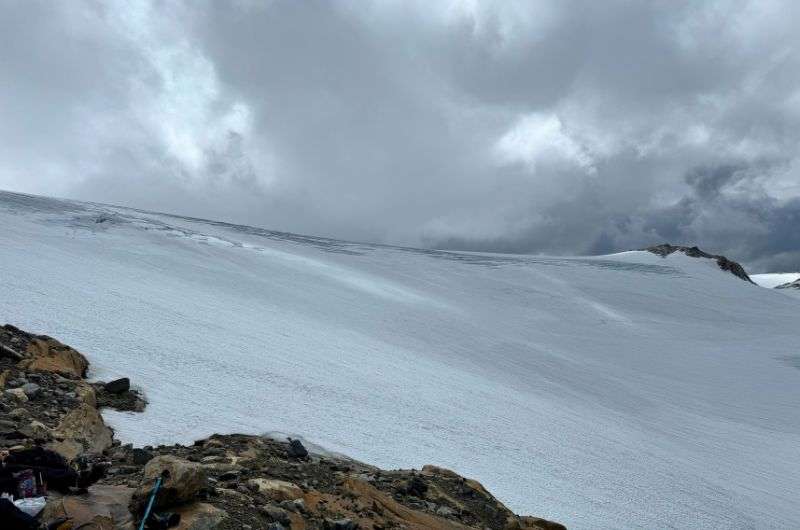
Summer skiing is definitely a thing to try in Norway!
You’ll find plenty to love at FONNA with high-altitude snow that holds up all summer long. You do need to be a relatively experienced skier to use its open pistes, and it has more challenging runs and a well-maintained freestyle park for the real show-offs.
- When? FONNA is typically open from May to September, but the exact dates float year-on-year.
- Where? The resort is located about a 30-minute drive from the village of Jondal.
- How? Get your passes and rent your gear there on the day, with full-day lift passes starting at NOK 465 (USD 42).
- Anything else? Wear layers and some sunscreen—the snow reflects the sunlight like crazy, and the glacier chill is real! Also, they’ve got a cozy café on-site if you need a break from the slopes for a hot chocolate.
2. The best things to do in Jostedalsbreen National Park
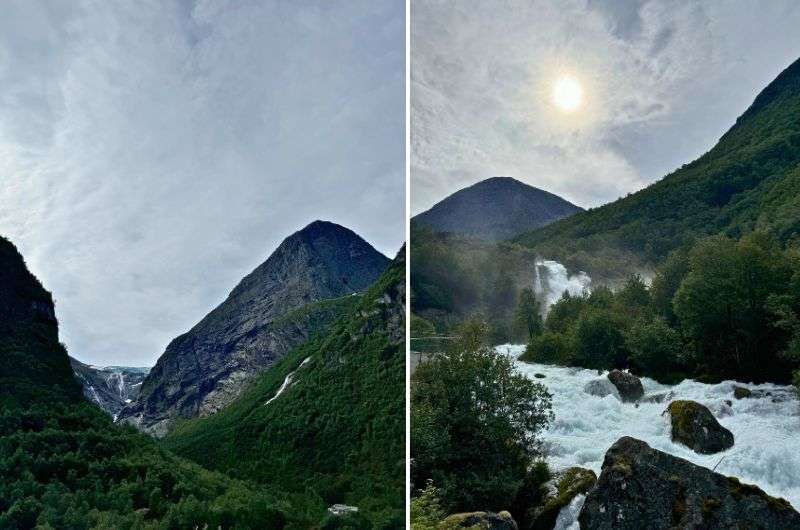
Jostedalsbreen National Park
What’s good to know
- Location: Vestland, southwest Norway
- My hotel recommendation: Stryn Hotel, Stryn
- What to expect: Glaciers, mountains, and a generous helping of waterfalls
Go hiking
Folgefonna’s got the glaciers, but Jostedalsbreen National Park is the land of glaciers and waterfalls (what a flex). Here, jagged cliffs and icy rivers spill down into green valleys; this is what I always thought the national parks of Norway would be like.
While there are countless trails to explore, these are my two favorites:
- Briksdal glacier (Google Maps link to trailhead): This is one of the park’s big attractions, and it’s easy to see why. The trail is pretty easy and well-marked, and it takes you along a river with waterfalls and rock formations that look straight out of a fairy tale.
- Oppstryn Skule to Segestad (Google Maps link to trailhead): This hike rewards you with incredible lake views and you’ll find way fewer people on it than at Briksdal. It’s an uphill hike through wild Norwegian forest and farmland, where you’ll pass old farms and grazing sheep. The view from the top had me questioning why I don’t live in a hut in the Norwegian wilderness full-time.
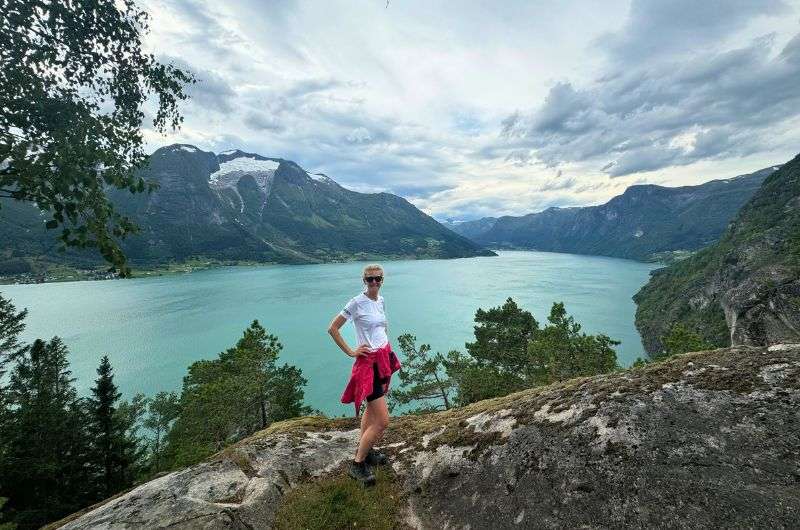
The beautiful lake views on Oppstryn Skule to Segestad trail
Go on a fjord cruise
If you’re the lazy type, fjord cruises through Jostedalsbreen National Park will give you the best seat in the house to see the waterfalls and valleys created by the glaciers themselves. It’s the best chance you’ll get to take everything in while staying dry and comfortable.
- When? Cruises and boat trips typically operate in the summer, from May to September.
- Where? Depart from fjordside villages such as Olden and Loen. Cruises go up and down Nordfjord, Innvikfjorden, and their surrounding lakes.
- How? Book through local tour operators, ideally in advance. Prices vary, with tours starting at around NOK 800 (USD 75).
- Anything else? Pack a jacket. Even on a sunny day, the fjord breeze is chilly.
Visit the Breheimsenteret glacier center
The Breheimsenteret glacier center is a must if you’re interested in the geology, history, and science behind these massive icefields. It’s basically a crash course on glaciers, topped off with an epic view of Jostedalsbreen glacier itself.
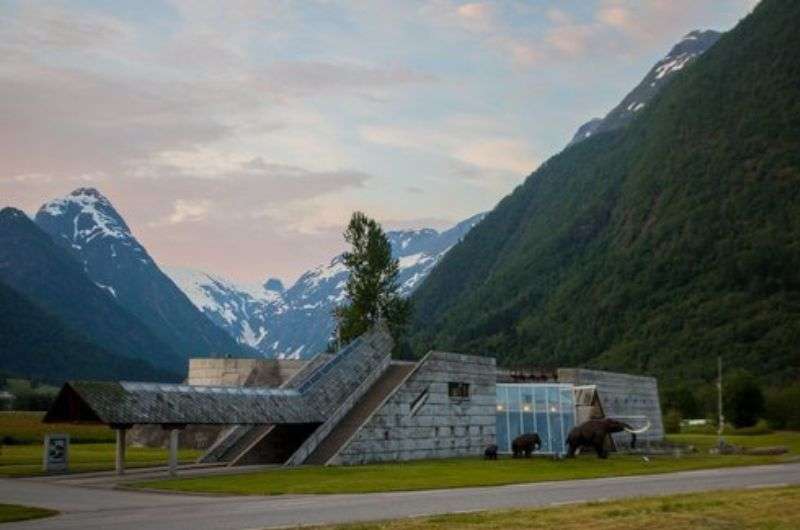
Visit Bremuseum.no
Plus, you can grab a hot drink at their café while you plan your next excursion. Just try not to let the exhibits on melting glaciers haunt you too much as you head back outside.
- When? Breheimsenteret is open from May to October.
- Where? The center seems like it’s in the middle of nowhere, but it's just north of the Gjerde campsite. (...Okay, so yeah, the middle of nowhere.)
- How? Tickets are available onsite and cost NOK 95 (USD 9).
- Anything else? Kids under the age of 10 go free!
3. The best things to do in Lofotodden National Park
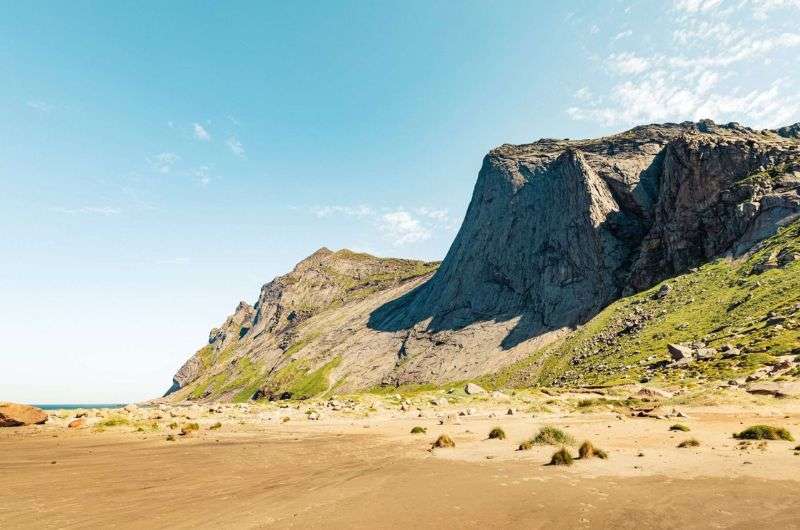
Lofotoddennp.com
What’s good to know
- Location: Lofoten Islands, Nordland, Northern Norway
- My hotel recommendation: Eliassen Rorbuer, Reine (adorable red cabins on stilts)
- What to expect: Majestic mountains, remote beaches, and if you’re lucky, the northern lights in winter
Hike up Reinebringen
Lofotodden National Park is the place to be if you like your hikes wild and windswept by a sea breeze. Here, you’re never far from rugged mountains, steep ridges, and green valleys. I’d even say it kind of reminded me of my trip to the Isle of Skye, only even colder. This is the Arctic Circle, after all!
The standout trail in Lofotodden for me is definitely Reinebringen (Google Maps link to trailhead). The views from the top of this peak are nothing short of epic, but this hike is not for the faint-hearted.
With over 1,500 stone steps (thanks to some handy Sherpa construction), it’s a steep climb, but it’s relatively straightforward and the 360-degree view over Reinevågen—the bay —is so worth it. Just bring good shoes and a hearty sense of adventure. Oh, and be prepared to share the view with a few friendly mountain sheep.
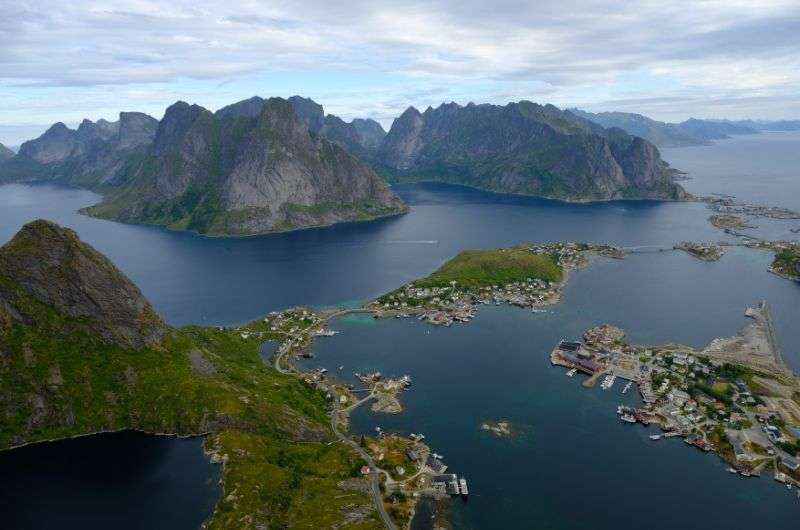
Reinebringen
Important note: The best time to hike up Reinebringen is from May to September. The trail gets icy as early as October, and you REALLY shouldn’t attempt it in winter.
Visit Bunes Beach
If you’ve ever wanted to feel like you have a beach all to yourself, Norway’s Bunes Beach is your dream come true. Accessible only by boat and a short hike, this secluded spot doesn’t see the same crowds as other popular Lofoten beaches, making it perfect for a day of peace and incredible scenery. If you ignore the cool temperature, being here does make you feel like you could be in the Caribbean.
Pack a picnic, stretch out on the sand, and enjoy some downtime, lounging under the midnight sun or wandering along the shore with dramatic mountains as your backdrop. It’s like a postcard from paradise—no tent required. (You can actually camp here, but me being me, I wouldn’t recommend it!)
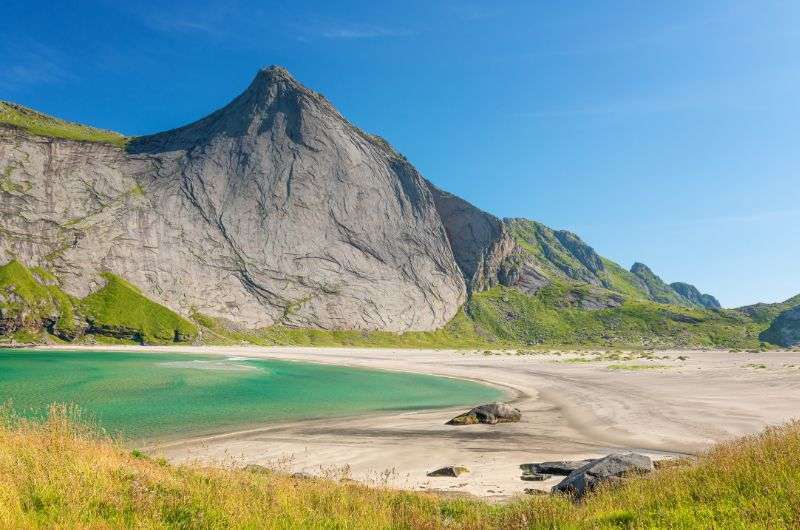
Bunes Beach
Fun fact: Considering how far north it is (68 degrees), Lofotodden National Park experiences one of the world's largest elevated temperature anomalies. This means it can reach the high teens (°C; low 60s in °F) in the middle of summer.
- When? The best time to visit is late May to early September when you’ll have midnight sun as well as the warmest weather.
- How? Catch a 45-minute ferry from Reine to Vindstad, then walk for around around 2 km [1.2 mi] to Bunes Beach. Book tickets in advance on reisnordland.no; prices start around NOK 150 (USD 14) one-way.
- Anything else? Bring everything you’ll need for the day, including food, water, and extra layers. And remember to collect all your trash to keep this spot as pristine as you found it.
Go fishing in the Norwegian Sea
It’s not just for old men; fishing is a way of life in Lofoten, and you can try your hand at it in Lofotodden National Park. The waters are rich with fish such as cod, halibut, and catfish, and it’s a great way to experience local culture firsthand. You can join a fishing trip and learn traditional techniques—or just take in the views while hoping for a big catch.
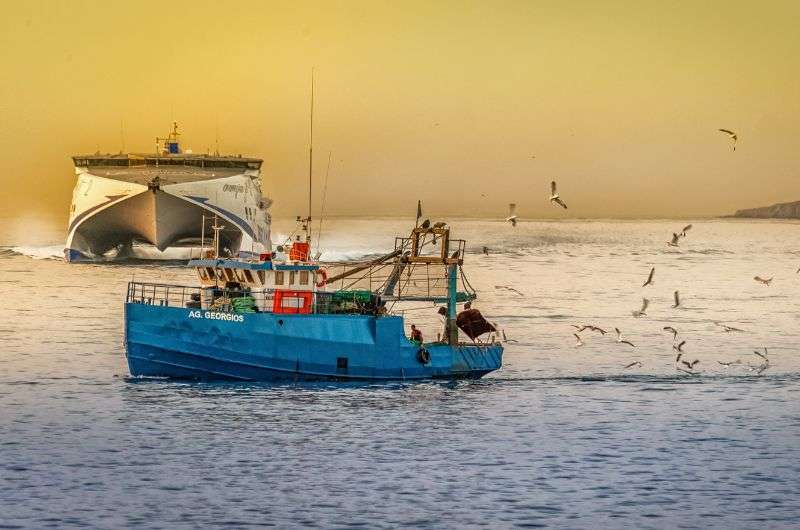
Try fishing as a traditional Norwegian activity
- When? Fishing trips operate year-round, but the cod season (January to April) is especially popular.
- Where? Tours go from Reine and Å (yes, that’s a real place name).
- How? There are a handful of fishing tour operators, and you can usually book online as well as on the spot at the harbors. The price at rib-lofoten.com is NOK 850 (USD 77), which includes all the gear you’ll need.
- Anything else? Aside from the small fish, be on the lookout for eagles, whales, sharks, and seals! This pretty much a maritime safari.
4. The best things to do in Jotunheimen National Park
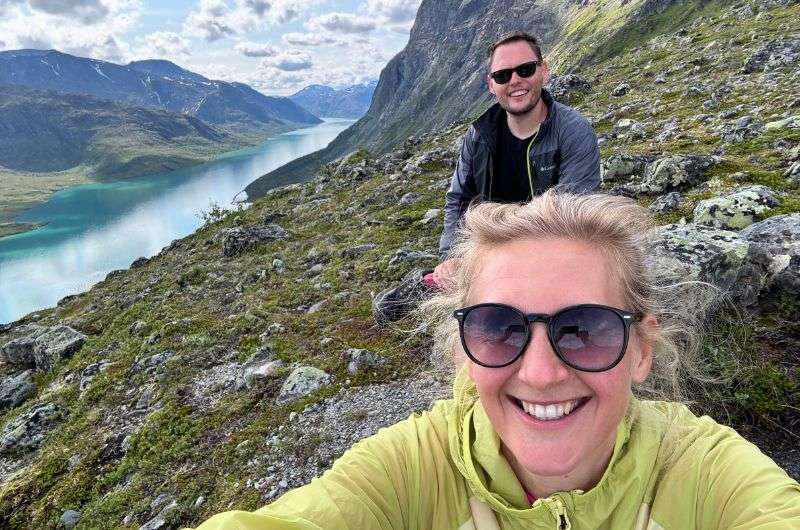
Our favorite activity was the Besseggen Ridge hike
What’s good to know
- Location: Innlandet and Vestland, central Norway
- My hotel recommendation: Radisson Blu Resort, Beitostølen
- What to expect: Jagged peaks, icy lakes, and just enough frozen wasteland to make you feel like you’re on a polar expedition
Go hiking
Jotunheimen National Park is Norway’s mountainous heart—home to the highest summits in Scandinavia (which to be honest, is the main reason to visit). Hiking here is next-level, and with trails that range from scenic strolls to heart-pounding scrambles, you’ll find a route for every taste and tolerance for altitude.
Here are two trails you can’t miss, in my opinion:
- Galdhøpiggen (Google Maps link to trailhead): As Norway’s highest mountain at 2,469 m (8,100 ft), Galdhøpiggen is both a badge of honor and an adventure. This one has two trailheads: Juvasshytta and Spiterstulen (Juvasshytta is easier, but more crowded). Look forward to giant boulders and glaciers, and I can only describe the view from the top as pure Norwegian magic!
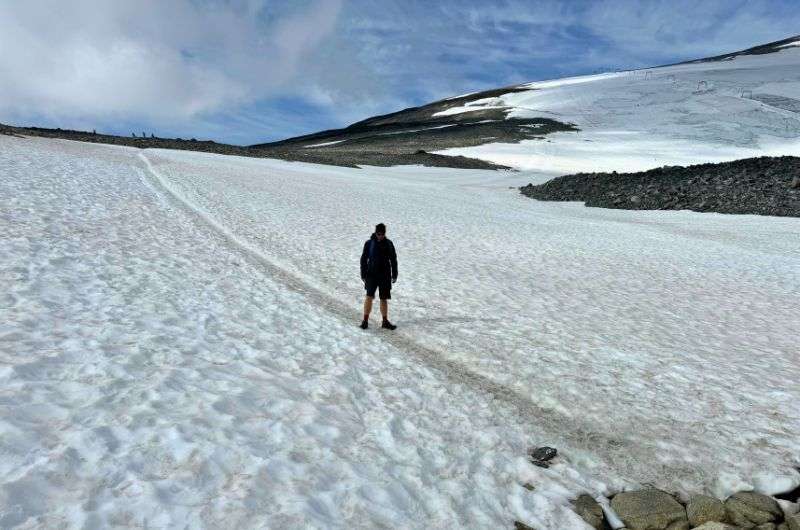
Me, on the Galdhøpiggen hike
- Besseggen Ridge (Google Maps link to trailhead): This is the hike for Instagram, your travel blog, or (if you’re over the age of 50) that postcard you’ll want to mail home. A rugged ridge line with dizzying drops on either side, Besseggen Ridge offers views over Gjende lake that are so surreal they look Photoshopped.
Bonus: The Besseggen Ridge hike either starts or ends with a ferry cruise on Gjende, which allows you to soak up the scenery from a different perspective. Want to learn more? Read all about my own experience hiking the Besseggen Ridge right here!
Important note: It gets chilly on Jotunheimen’s high-altitude hikes, so pack extra layers and snacks. Also, be prepared for a little rock-hopping.
Go horseback riding
For a different way to explore Jotunheimen consider horseback riding. I must say, there’s something magical about riding through mountains and open fields to the sound of hoofbeats. It’s a serene and timeless way to see some of the park, and the views from horseback are, as always in Jotunheimen, spectacular.
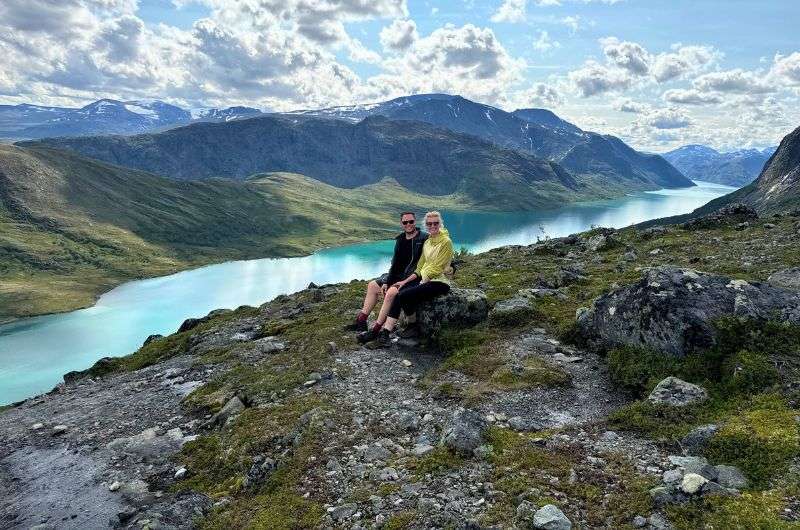
You can't get to the Besseggen Ridge on horseback, but you can explore other parts of Jotunheimen on it
- When? Riding tours are available from June to September.
- Where? Guided rides are offered from various points around Jotunheimen, including Lom and Bøverdalen.
- How? Book in advance; I recommend Jotunheimen Equestrian Centre at Raubergstulen. Prices vary but expect to pay around NOK 700 (USD 60) for a half-day ride.
- Anything else? Wear long pants and bring a windproof jacket.
Go cross-country skiing
Come winter, Jotunheimen transforms into a cross-country skier’s paradise. Its expansive valleys and frozen lakes make for perfect ski trails, offering a peaceful yet challenging way to take in the landscape.
With fresh snow underfoot and frost-covered peaks all around, you’ll feel like you’re gliding through a winter wonderland. The Norwegian Trekking Association maintains some routes and huts for overnight ski trips, so you can make it a multi-day adventure.
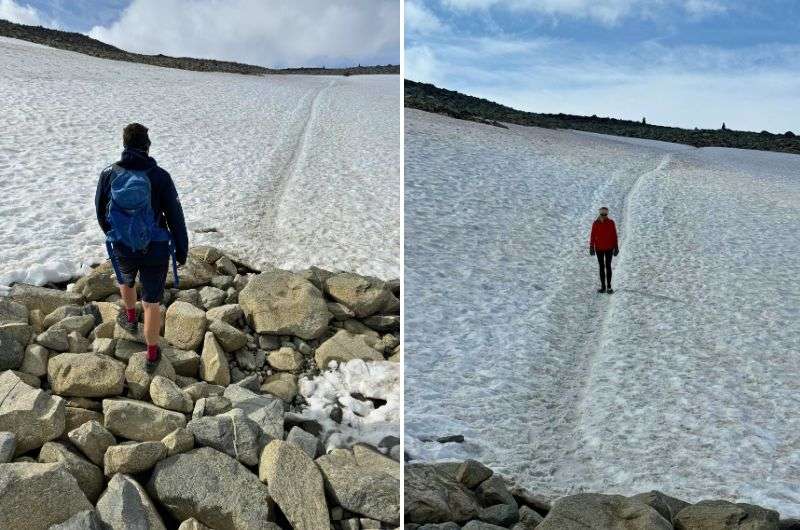
Cross-country skiing is possible until April in Jotunheimen National Park
- When? The best time to go cross-country skiing in Jotunheimen National Park is between December and April.
- Where? There’s a well-known ski trail that starts by Lemonsjøen lake and ends near Gjende. Don’t worry—you don’t have to go the entire way if you don’t want to!
- How? Bring your own skis or rent from local operators. Guided ski tours are also available for those wanting a little extra support.
- Anything else? Check trail conditions before heading out, including for the potential of avalanches. And Jotunheimen is one of the best places in Norway to spot wild reindeer, so keep your eyes open!
5. The best things to do in Hardangervidda National Park
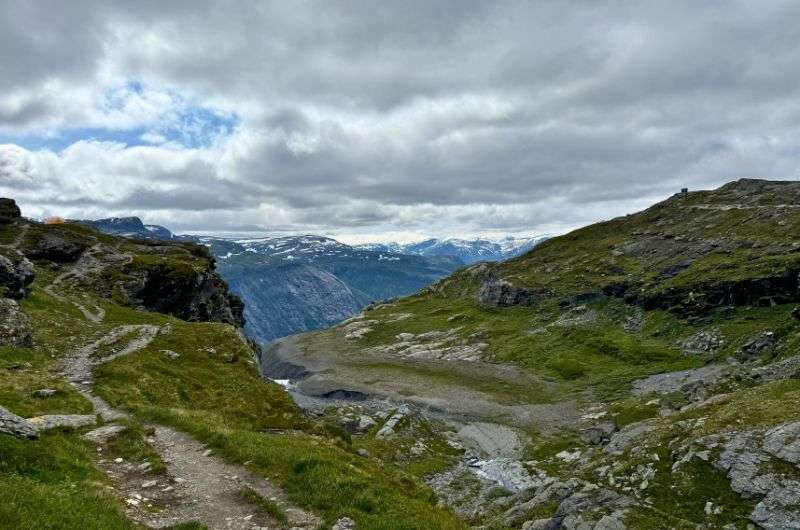
In Hardangervidda National Park is the famed Trolltunga hike trail
What’s good to know
- Location: Buskerud, Vestland, and Telemark, southern Norway
- My hotel recommendation: Trolltunga Hotel, Odda
- What to expect: Vast, open plateaus, lakes galore, and the feeling that you’ve wandered into a Viking epic
Go hiking
Hardangervidda is Norway’s largest national park, spanning three counties, and to be honest, it was my own hiker’s dream. This place is like Norway’s largest rooftop, with wide-open plateaus, more glacial lakes, and spots that genuinely feel like the edge of the earth.
Bonus: Hardangervidda is near to Folgefonna National Park, on the other side of Hardangerfjord. This means you could do a two-for-one if you can’t decide which Norwegian national park to visit!
Here are my top two hikes to do in Hardangervidda National Park (from my own experience):
- Trolltunga (Google Maps link to trailhead): One of Norway’s most iconic hikes and located just outside Hardangervidda, Trolltunga is a tough, 26-kilometer (16-mile) round-trip trek. It’s so worth it, believe me, but give yourself a pep talk and read all about my own trip up Trolltunga before you set out.
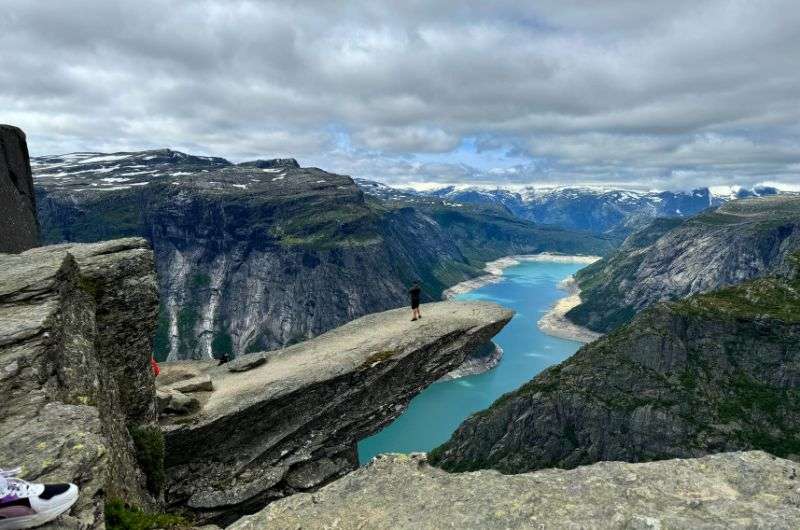
Can you see the Troll’s tongue there?
- Nykkjesøyfossen (Google Maps link to trailhead): This trail is tucked away in one of the quieter corners of Hardangervidda National Park, with the trailhead being just outside Kinsarvik. It finishes at the Nykkjesøyfossen waterfall, but it leads you past two other stunning falls on the way. Unless you want a hose-down, wear waterproof clothing.
Visit the Norwegian Nature Center
For a dose of nature education, stop by the Norwegian Nature Center. The center has interactive exhibits on the country’s geology, wildlife, and ecosystems, including everything you ever wanted to know about reindeer. There’s a particular focus on the Hardangervidda area.
It’s a great way to take in the science of the landscape you’re exploring, and there’s even a cinema for an epic panoramic film of the best landscapes that this part of the world has to offer. My advice is to save this one for a rainy day, which shouldn’t be too difficult when vacationing in Norway.
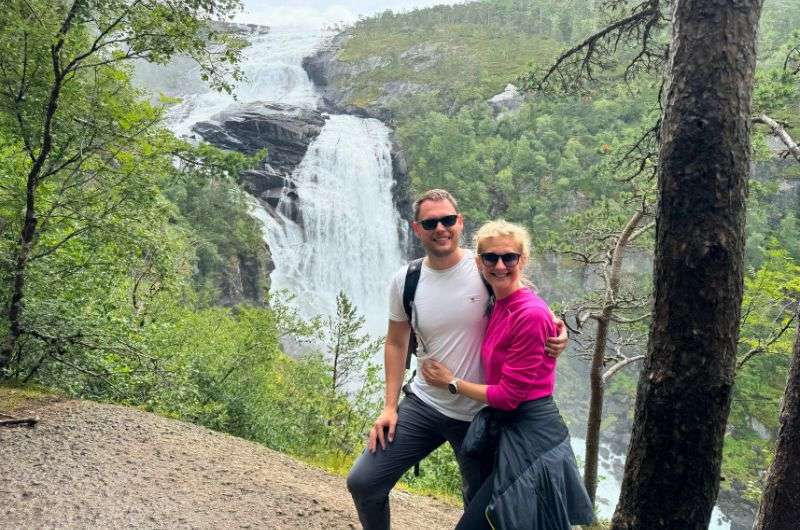
The beautiful travelers and the beautiful nature on Nykkjesøyfossen hike
- When? The Norwegian Nature Center is open from the end of March until the end of October.
- Where? You’ll find it close to Eidfjordvatnet (Google Maps link).
- How? Get tickets on arrival. Admission prices start at NOK 180 (USD 16) for adults, with family tickets available from NOK 440 (USD 40).
- Anything else? The center has a great café for grabbing a post-hike snack.
6. The best things to do in Rondane National Park
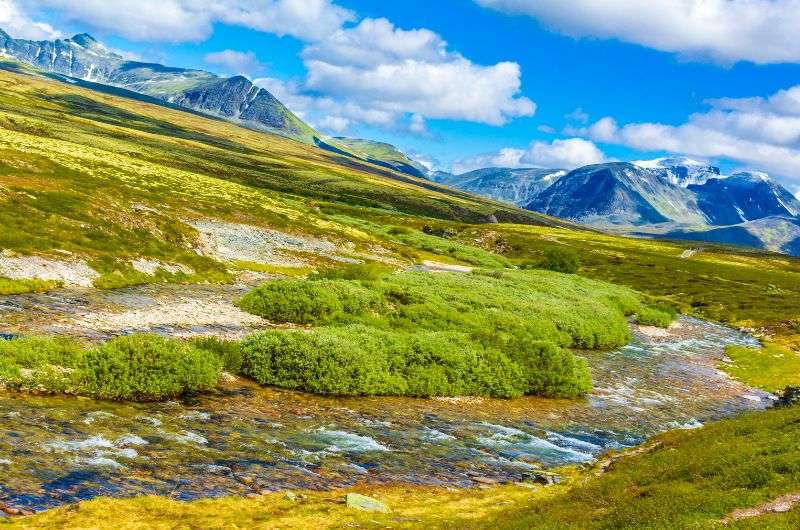
Rondane National Park
What’s good to know
- Location: Innlandet, central Norway
- My hotel recommendation: Thon Partner Hotel, Otta
- What to expect: Rocky peaks, serene valleys, and a chance to spot some reindeer in the wild
Hike up Rondeslottet
Rondane National Park is Norway’s oldest national park, established in 1962 (which doesn’t seem that old to me, frankly). It’s another wonderful place to be a hiker, boasting 10 peaks over 2,000 m (6,500 ft).
There’s one very obvious hike to take on here, and that’s Rondeslottet (Google Maps link to trailhead). Admittedly, this one is for the ambitious, so if you’re unfit and inexperienced, leave this out of your itinerary. (But don’t worry, I’ll get back to you soon with a much gentler walk...!)
There is no real path—just rocks in sheer abundance, although there are markings to guide you. The trail is 12.4 km long (7.7 mi) in total, and it gets very steep. In other words, be prepared for some scrambling.
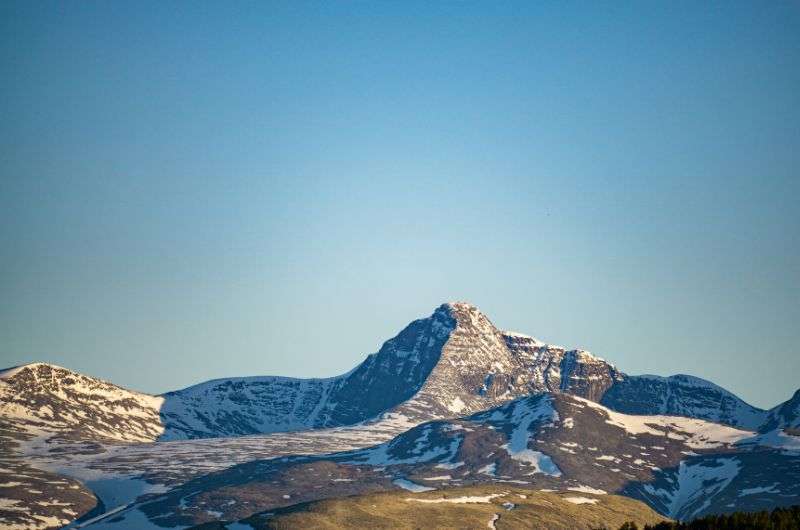
Rondslottet
At 2,178 m (7,145 ft), Rondslottet is the highest peak in Rondane, which basically makes it the “king” (the name literally means "Rondane's Castle"). When you’re standing at the top looking out over the entire park, it does very much feel like you’re Norway’s rightful ruler.
Important note: Allow at least six hours to complete the route; ideally even longer so you’ll definitely have time to go slowly and steadily on the toughest portions.
Go mountain biking
For a national park as rocky as this one, Rondane is surprisingly bike-friendly! There are several trails open to mountain bikers, which is a fantastic way to cover more ground and take in those wide-open landscapes without so much uphill sweat. The trails range in difficulty, so there’s something for every rider.
- When? The best months to go mountain biking in Rondane National Park are June through September.
- Where? Start from the small village of Mysusæter and follow any one of the marked trails. I’d recommend heading towards Furusjøen, where you’ll find amazing lakeside views.
- How? You can rent bikes (self-service) from the parking lots in Mysusæter for around NOK 300 (USD 27) per day. There are also opportunities to do this in Otta, which is around 14 km (8.7 mi) away.
- Anything else? Watch out for wild reindeer crossing the trails! And remember to pack a bike repair kit in case the rocky terrain decides to challenge your wheels.
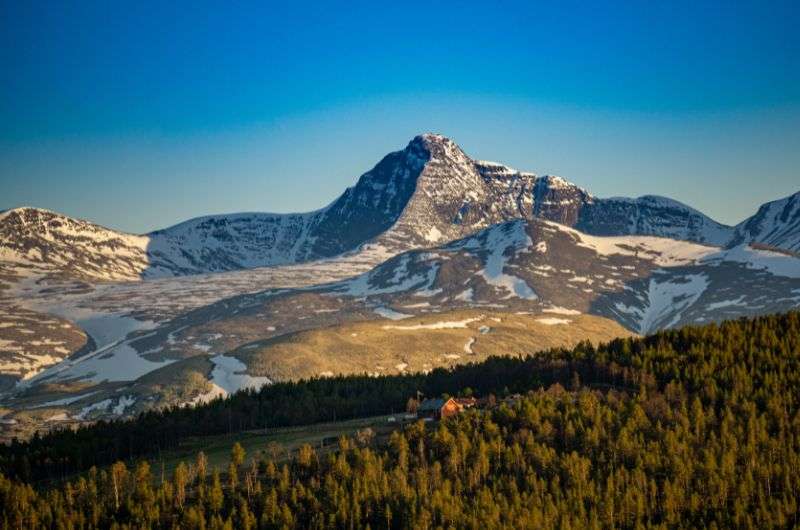
Rondane is full of mountains, suitable for mountain biking
Visit Kvitskriuprestene (the White Priests)
This is one of the Rondane’s more unusual sites. Kvitskriuprestene, or “the White Priests” (which is so much easier to pronounce), are natural sand pillars formed by centuries of erosion.
These strange formations stand tall along the hillside and give you a glimpse into Rondane’s fascinating geological past. It’s an easy stop and offers a bit of a change from the usual mountain scenery. (Though to be honest, if you easily get sick of mountains, I highly recommend you don’t come to visit any of the national parks of Norway.)
- When? The White Priests are accessible all year round, though summer is best.
- Where? To get there, drive to the designated parking lot around 4 km (2.5 mi) northeast of Otta, and then it’s just a 10-minute walk up some steps (Google Maps link).
- Anything else? The walk to the White Priests is easy, so it’s a good stop for families or anyone looking for a less strenuous way to experience Rondane National Park’s stellar landscapes. (See, I told you I’d get back to you, unfit reader!)
7. The best things to do in Breheimen National Park
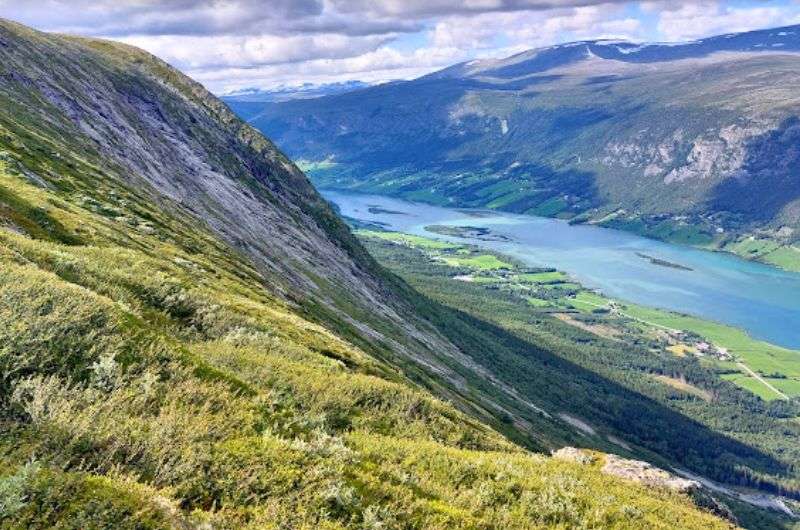
Breheimen National Park
What’s good to know
- Location: Innlandet and Vestland, central-western Norway
- My hotel recommendation: Pollfoss Hotel, Skjåk
- What to expect: Glaciers, waterfalls, and lush valleys that never seem to end
Go glacier hiking
“Breheimen” means “the home of the glaciers,” so you can bet there’s some epic glacier action here. Plus, because this national park lies between Jostedalsbreen and Jotunheimen, you’ll assume correctly that the landscapes are very similar.
BUT, both Jostedalsbreen and Jotunheimen attract more visitors, so Breheimen’s glaciers feel like a private icy kingdom just waiting to be explored. Glacier hiking here is challenging but deeply rewarding—nothing quite beats the view of massive blue ice fields backed by dramatic mountains.
Here are a couple of the best hikes to get you up close to the glaciers:
- Nigardsbreen (Google Maps link to trailhead): Technically just outside Breheimen, but close enough to count. Nigardsbreen is an accessible glacier and offers guided tours suitable for beginners. This place is just mind-bogglingly beautiful, and walking on top of a glacier with deep blue ice formations is an experience you won’t forget.
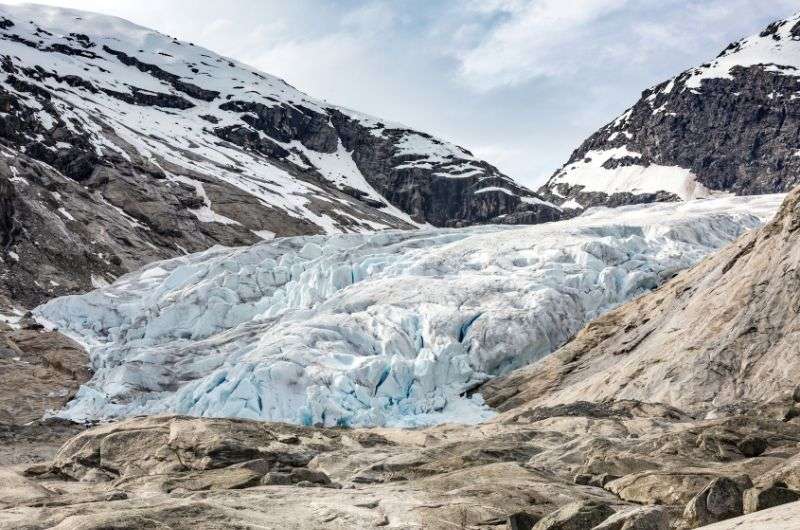
Nigardsbreen glacier
- Tverrådalskyrkja (Google Maps link to trailhead): This is one of the more adventurous spots in Breheimen, leading you up to the Tverrådalskyrkja peak. Nope, it’s not a glacier itself, but the steep, rugged route to the top involves skirting around those icy crevasses. Be prepared for this challenging 22.5-kilometer (14-mile) hike by setting aside a whole day.
Important note: Remember, glacier hiking is not a solo activity! Go with a certified guide—glaciers are majestic, but they’re also slippery, unpredictable, and, you know, full of deep holes.
Find the hidden waterfalls in the Fortun valley
Who doesn’t love a waterfall? The valley surrounding the village of Fortun is peppered with waterfalls cascading down steep cliffs. Far be it from me to suggest spontaneity, but if you simply go exploring here along the river, it won’t be long before you come across smaller, hidden trails that lead to secluded falls.
- When? The best time to go exploring in Breheimen National Park is from late spring to early fall.
- Where? Park in Fortun (Google Maps link), a small village at the eastern edge of the national park. Take your pick of any of the trail signs and see where you end up!
- Anything else? Bring a camera—these waterfalls are the real deal and look magical even on a cloudy day.
8. The best things to do in Møysalen National Park
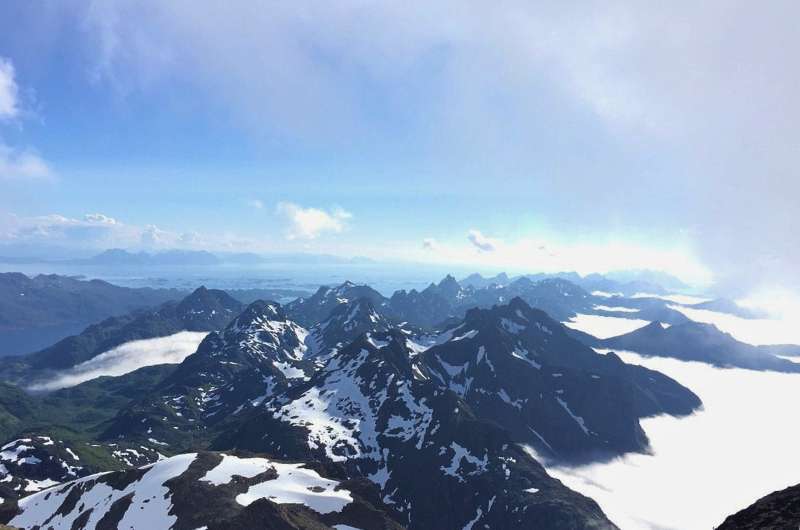
Møysalen National Park
What’s good to know
- Location: Nordland, Northern Norway
- My hotel recommendation: Scandic Sortland, Sortland
- What to expect: Towering peaks, fjordside trails, and lush forests
Hike up Møysalen
Møysalen National Park is rugged, wild, and feels like it’s barely been touched by human hands. Named after Møysalen mountain, the hikes here grant you 360-degree fjord views and some of the most dramatic scenery you’ll find in Norway. If you like a challenge, hiking to the Møysalen summit is an absolute must.
Fun fact: Møysalen is the highest mountain not just in the national park, but in the entire Lofoten and Vesterålen area.
The hike starts in the village of Kaljord (Google Maps link to trailhead) and is about a 23-kilometer (14-mile) round-trip. There are steep climbs, boulder scrambles, and a little glacial trekking toward the top, so be ready for a workout. But standing on the summit, 1,262 m (4,140 ft) above sea level, with views over fjords and islands, you’ll feel, 1: like you’re on top of the world; and 2: probably a bit dizzy.
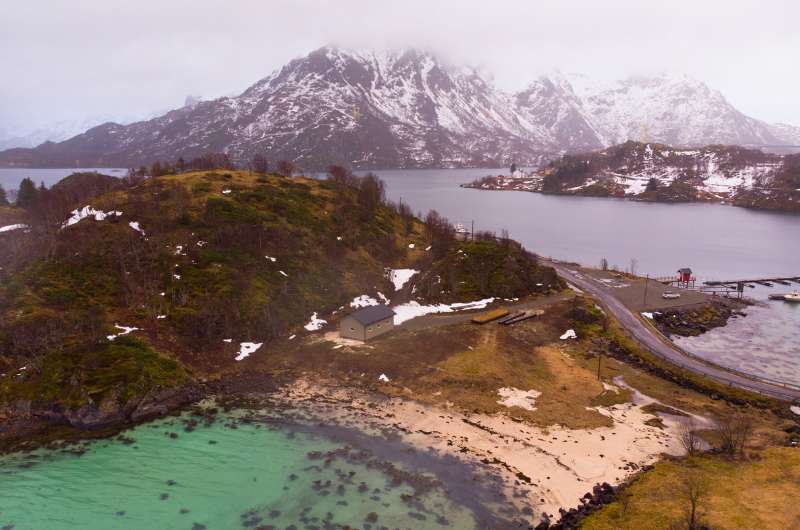
Møysalen National Park
Explore an Arctic forest
The area surrounding Møysalen National Park is home to one of the northernmost temperate forests in the world, thanks to the constant moisture and unique climate here. These lush, green sections of the park’s untouched nature kind of feel worlds apart from the typical Norwegian landscape of peaks, fjords, and glaciers.
The best way to experience the forest area is by hiking through it on one of the lower trails. The paths wind past streams and a whole lot of greenery that you probably didn’t expect to see this far north (68 degrees, in case you were wondering).
- When? Generally, Møysalen forest trails are accessible from May to September.
- Where? Wherever you are in the national park, you won’t need to go too far to find a forested area. One place to start would be the small village of Hennes (Google Maps link), where there are trail maps and information.
- Anything else? Watch your step! The trails can be slippery and muddy, and you might come across a bog that you definitely don’t want to put your foot through (unless you’re wearing waders).
Go whale watching
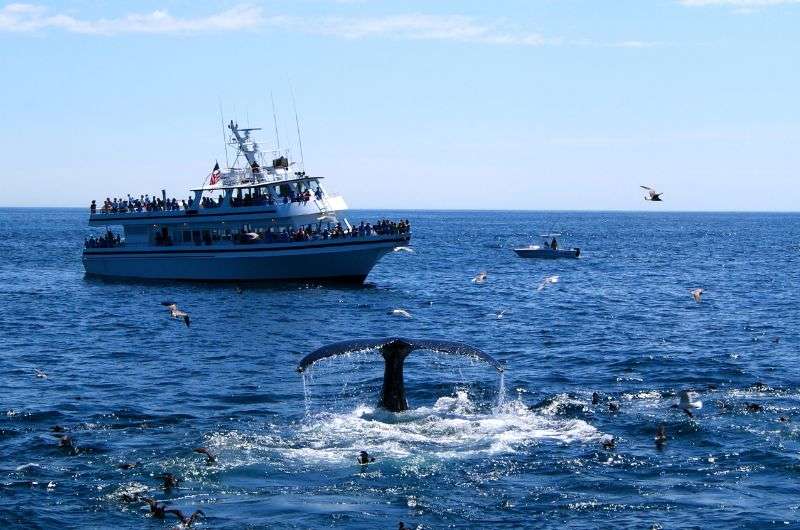
Watching whales in Norway is always a good idea
Being so far north, the Møysalen area is ideally located for whale watching. And the brilliant news is that Vesterålen is the only Norwegian destination where it’s possible to do it all year round!
Whale watching tours take you out to sea, where you can experience the thrill of seeing these giants in the wild. This is your chance to spot sperm whales or even the occasional orca. It’s a surreal experience—some people even report crying out of joy, but I find that a bit weird.
- When? Although whale watching tours in this part of the world are operated all year round, the very best time for whale watching is from May to September, when you’ll most likely get the best weather for it.
- Where? The best tours depart from Andenes (Google Maps link).
- How? Book a tour online at whalesafari.no; it costs NOK 1,595 (USD 143) for a three-hour trip. And make sure you get in early! Tours can be booked up months in advance.
- Anything else? If you don’t see any whales, they’ll give you a free ticket for their next outing.
Do you have to pay for national parks in Norway?
No, you don’t have to pay to enter national parks in Norway. Access is free and the right to roam applies. Many of the parks have well-maintained trails and some basic facilities, but keep in mind that there aren’t entry gates like you might find in other countries. Important note: Make sure to follow the Leave No Trace principles to keep these wild spaces pristine.
Can you free camp in Norway?
Yes, you can free camp in Norway. According to the right to roam, wild camping is permitted for free on uncultivated land for up to two nights (or longer in remote areas). This is true as long as you respect private property boundaries and stay at least 150 m (492 ft) from inhabited houses or cabins.
How many national parks are there in Norway?
As of 2024, Norway has 48 national parks, with 41 in mainland Norway and 7 on Svalbard (the Arctic archipelago). Here, I cover the most popular of these 48 to visit, as well as my personal favorites, including:
- Jotunheimen National Park (for hiking, horseback riding, and cross-country skiing)
- Jostedalsbreen National Park (for hiking and fjord cruises)
- Folgefonna National Park (for glacier trekking, glacier kayaking, and summer skiing)
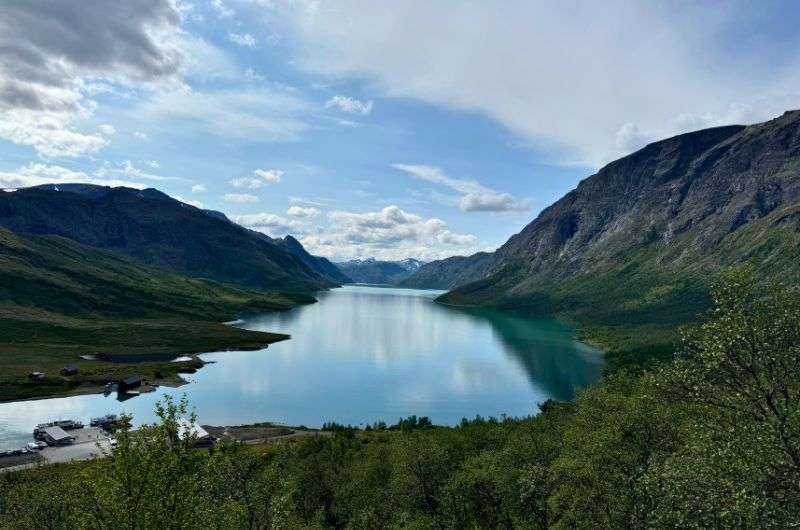
There are 48 national parks in Norway
Which national park is near Oslo?
Nordmarka, which is technically a protected forest, is the closest large natural area to Oslo. Lots of people who are based in Oslo make use of this area’s hiking, biking, and skiing opportunities, even just for day trips.
The closest official national parks to Oslo are Ytre Hvaler National Park (to the southeast) and Færder National Park (to the southwest). These are both marine national parks on the coast of the Skagerrak strait.
However, the most popular national park to visit from Oslo is Jotunheimen National Park, which is a 3- to 4-hour drive away. Here you’ll find epic mountains, valleys, and lots of outdoor activity opportunities.
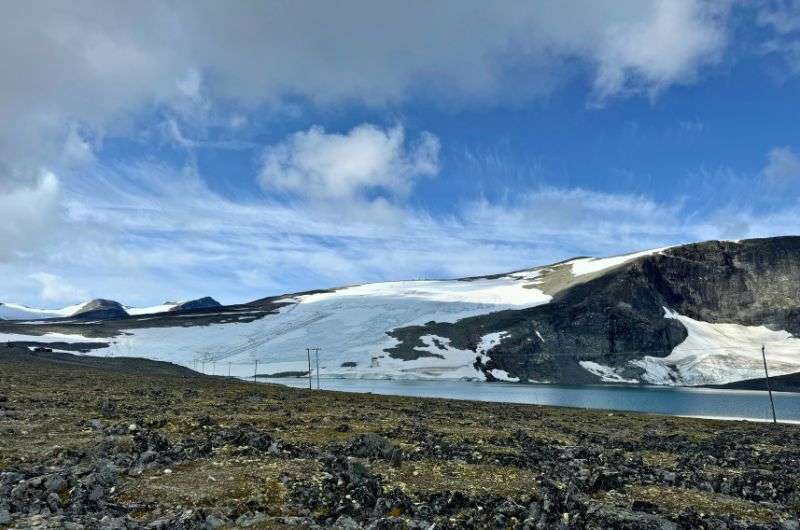
Jotunheimen National Park
How do you get to Jotunheimen National Park from Oslo or Bergen?
- From Oslo: The easiest way is by car—head northwest on the E16, then exit onto the Rv15. It’s about a 4-hour drive.
- From Bergen: Again, by car, take the E39 northeast before turning off onto the Rv15. This journey takes around 7 hours.
Pro tip: There’s also public transport available from Oslo to Jotunheim National Park by way of trains and buses. I recommend going to entur.no to plan any journey by any means across the whole of Norway.
Sometimes, all you need to do is take the first step... I've filtered out the best hotels in Norway for you
Save it for yourself to come back to later, or share with your friends on social media!
This post contains affiliate links. I earn a small commission if you make bookings through my links, at no additional cost to you. Thank you for your support!




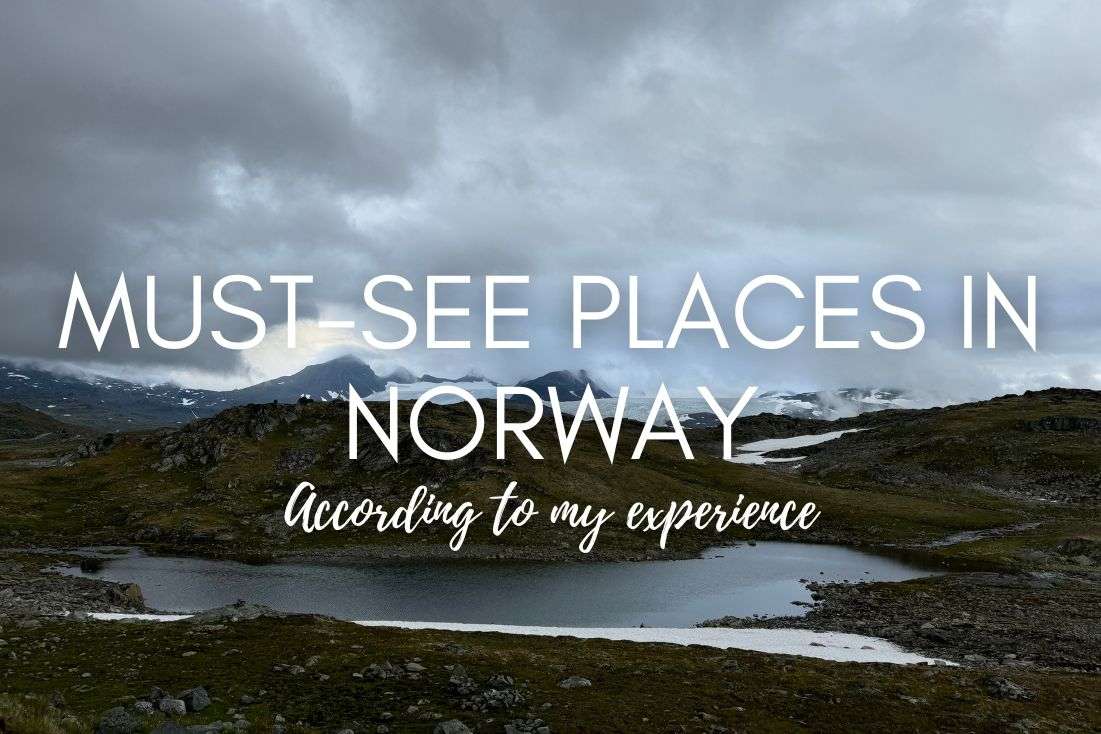
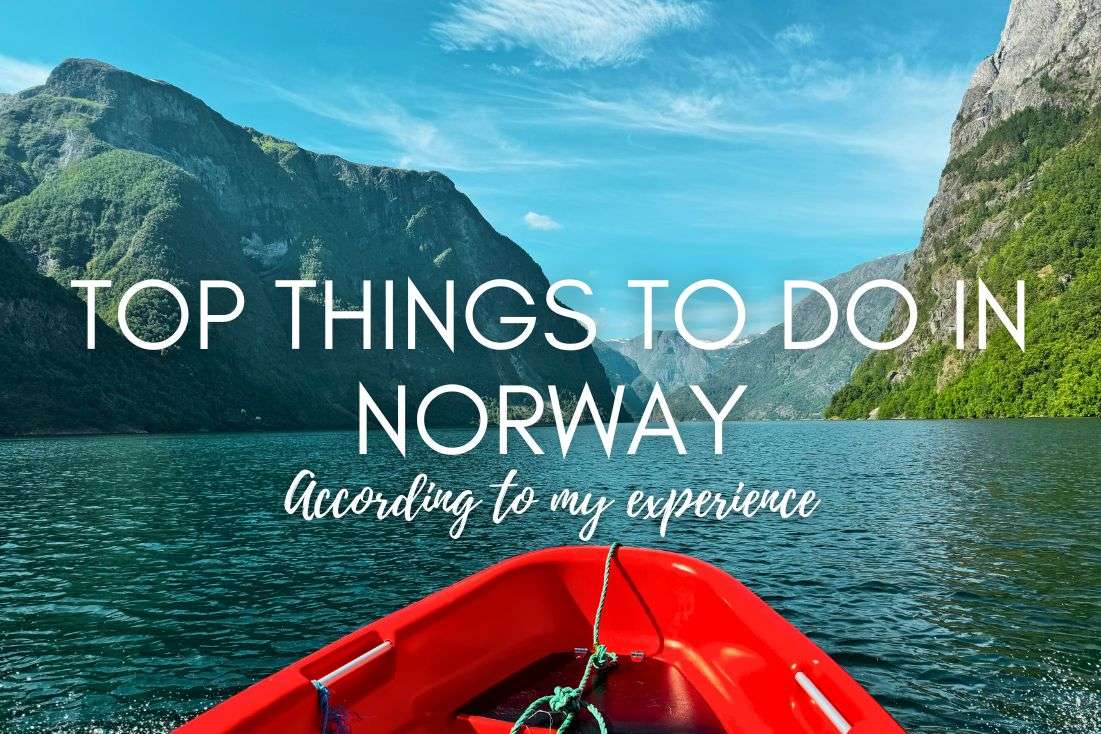
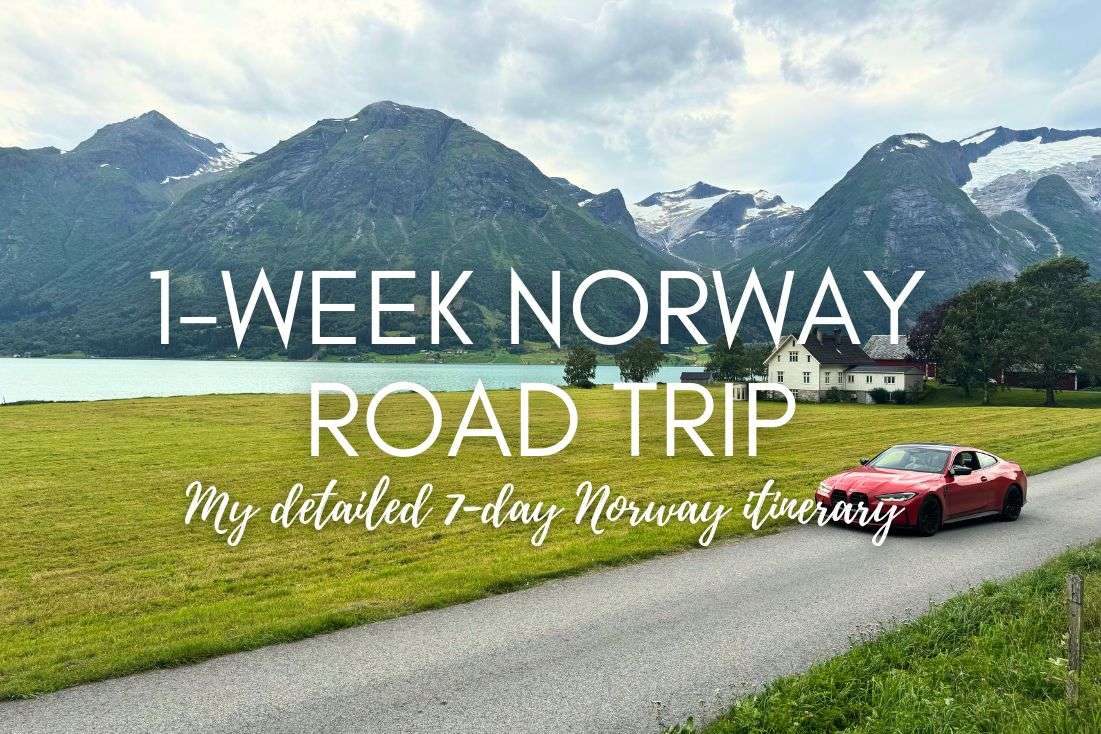



Comments | Thoughts? Give us a shout!